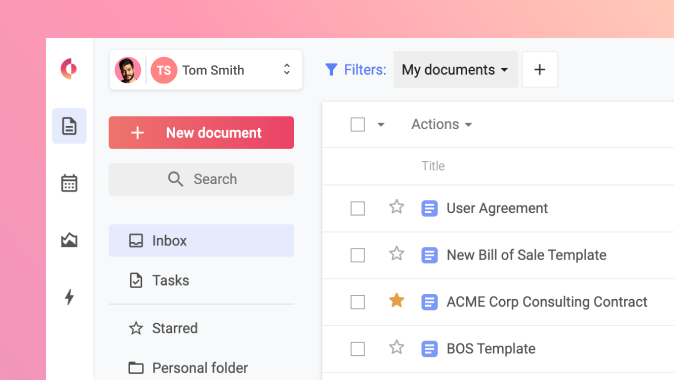Clickwrap Agreements: Definition and Requirements
Table of contents
- What is a clickwrap agreement?
- When can I use a clickwrap agreement?
- What evidence do I need to enforce a clickwrap agreement?
- How do clickwrap agreements compare to other types of e-signatures?
- How can clickwrap agreements streamline contract management?
-
About Concord
Effortless contract management, from drafting to e-signing and beyond. Book a live demo to see Concord in action.
Request demo
Clickwrap agreements have become central to online consent, enabling businesses and consumers to agree on terms seamlessly. Here, we’re going to see what clickwrap agreements are, what makes them legally enforceable, and what sets them apart from other types of electronic signatures.
We’re also going to look at how clickwrap agreements can be used to streamline contract management processes. Once you understand what they are and how they work, you’ll be better equipped to navigate online transactions – and to broker them using clickwrap methods. Let’s dive in.
What is a clickwrap agreement?
A clickwrap agreement is an online contractual agreement where users signify their acceptance by clicking a button or checking a box that states “I agree” or something similar. Here are the core components that characterize clickwrap agreements:
- User interaction and consent: The user must perform an action to demonstrate agreement, usually by clicking a button or ticking a checkbox.
- Display of terms and conditions: The terms and conditions are provided for the user to read before agreeing. They must be easily accessible, typically on the same page or via a hyperlink.
- Record keeping and audit trails: A record of the user’s agreement is kept, including a timestamp and the version of the terms agreed upon. This is crucial for legal enforceability and for auditing purposes.
When can I use a clickwrap agreement?
You can use a clickwrap agreement in a variety of business scenarios. Here are some of the most common use cases:
- Online transactions: When selling goods or services online, clickwrap agreements facilitate smooth transactions by making sure consent is clear.
- User registrations: During account creation, you may want to clarify your platform’s terms of service and privacy policy through clickwrap agreements.
- Software licenses: Before users download or access your software, you may want them to agree to your licensing terms via a clickwrap agreement.
- Content subscriptions: Subscribers can use a clickwrap agreement to explicitly agree to your terms for a newsletter, software-as-a-service (SaaS) platform, or a streaming service.
- Updates to terms: You can use clickwrap agreements to obtain agreement from existing users when you make changes to your terms of service or privacy policy.
Across all these use cases, clickwrap agreements demonstrate explicit consent, making them a versatile tool for online interactions with your customers.
Are clickwrap agreements legally enforceable?
Yes, clickwrap agreements are legally enforceable, as long as they adhere to certain guidelines. Here are some key factors that contribute to the legal enforceability of clickwrap agreements:
- Clear presentation of terms: The terms and conditions should be clearly visible and accessible to users before they agree. They should not be hidden away or presented in a manner that’s difficult to read.
- Explicit action of agreement: Users must take a distinct action to indicate their agreement, such as clicking a button labeled “I agree.” This explicit action is a strong indicator of the user’s consent to the terms presented.
- Accessible record of acceptance: Maintaining a retrievable record of the user’s acceptance, complete with a timestamp and the version of the terms agreed upon, is crucial for legal enforceability.
Real-world legal cases have clarified the legal enforceability of clickwrap agreements. For instance, in the case of “Specht v. Netscape Communications Corp,” the courts favored the enforceability of clickwrap agreements as long as the terms are clearly presented and the user’s agreement is explicitly obtained.
What’s more, the Uniform Electronic Transactions Act (UETA) and the Electronic Signatures in Global and National Commerce Act (eSIGN Act) explicitly establish the legality of electronic signatures, which include clickwrap agreements. These laws specify that electronic records and signatures hold the same legal standing as their paper and ink counterparts, as long as that the consenting parties have agreed to proceed electronically.
What evidence do I need to enforce a clickwrap agreement?
To enforce a clickwrap agreement, you’ll need to have all the following forms of evidence:
- Explicit acceptance: Proof that the user explicitly accepted the terms by clicking “I agree” or a similar affirmation.
- User awareness: Evidence that the user had actual or inquiry notice of the terms.
- Design and layout: Screenshots or records showcasing the design and layout of the page containing the clickwrap agreement, ensuring it was clear and noticeable.
- Back-end records: Documentation like timestamps and user actions, which prove the user’s interaction with the agreement.
- Screenshots: Images capturing what the screen looked like at the time of agreement, supporting the clear presentation of terms.
With these pieces of evidence, you’ll be in a strong position to enforce a clickwrap agreement that another party has signed.
How do clickwrap agreements compare to other types of e-signatures?
Electronic signature formats vary widely, and each of them serves distinct purposes and addresses different legal considerations. Here, we’ll dissect the differences between clickwrap agreements and other popular types of e-signatures:
- Browsewrap agreements:
- Consent mechanism: Unlike clickwrap, browsewrap agreements assume user consent merely by their use of the website. There’s no explicit action required to agree to the terms.
- Legal enforceability: Due to the passive nature of consent, browsewrap agreements may face tougher legal scrutiny compared to clickwrap agreements.
- Typical usage: Often used in websites for general terms of service, especially where user transactions are not the focus.
- Sign-in-wrap Agreements:
- Consent mechanism: These are a hybrid, where users signify agreement by signing up or logging in, often with a phrase near the sign-in button indicating agreement to the terms.
- Legal enforceability: Legal enforceability can be strong, provided the terms are clearly accessible and the sign-in process clearly indicates agreement.
- Typical usage: Common in platforms requiring user accounts or subscriptions.
- Standard e-signatures:
- Consent mechanism: Users provide consent by typing their name, drawing a signature, or using a secure e-signature platform.
- Legal enforceability: Generally highly enforceable, especially when using secure, verified platforms that comply with laws like the ESIGN Act and UETA.
- Typical usage: Used for formal contracts and documents requiring a traditional signature.
Clickwrap agreements are known for their explicit consent mechanism, which aligns well with legal standards while offering a clear user experience. The straightforward action of clicking an “I agree” button is an unambiguous act of consent, which makes clickwrap agreements user-friendly.
Even so, when you need a higher level of identity verification and legal enforceability, legally binding advanced e-signatures (AES) may be the more suitable choice.
How can clickwrap agreements streamline contract management?
Clickwrap agreements can streamline contract management across all the following areas:
- Automated consent capture: Clickwrap agreements automate the consent capture process, reducing manual work and accelerating contract processes.
- Clear audit trails: In combination with contract lifecycle management (CLM) software, clickwrap agreements can be part of a digital audit trail, demonstrating who has signed a document, and when.
- Enhanced user experience: A clickwrap signing step serves as a a quick and unambiguous consent process, providing a positive experience for third-party signers.
- Reduced legal risks: By obtaining explicit consent, clickwrap agreement help mitigating many legal risks associated with online transactions.
- Cost-effectiveness: By digitizing and automating your consent processes, you’ll be able to finalize more contracts in less time, at lower cost.
For all these reasons, clickwrap agreements can help facilitate seamless online transactions, and make your contract management process more effortless. Now that you’ve got a stronger grasp of what they are and how they work, you’ll be ready to implement them in your own deal pipelines.
Streamline your e-signing processes today.
Concord CLM makes agreements effortless.



